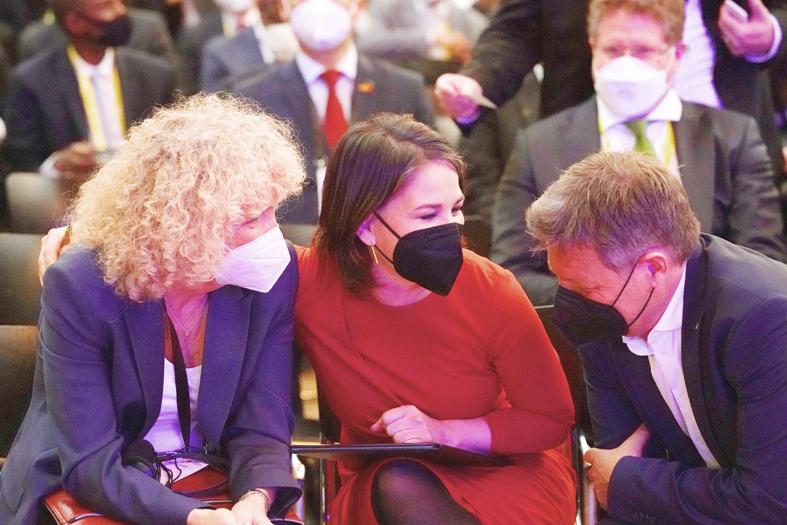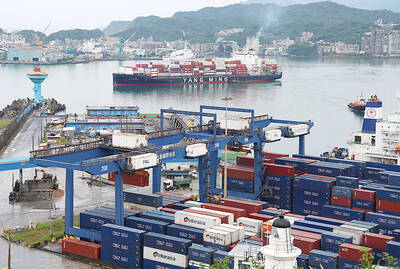The G7 major economies on Monday agreed to reject Moscow’s demand to pay for Russian natural gas exports in rubles.
“All G7 ministers agreed completely that this [would be] a one-sided and clear breach of the existing contracts” for natural gas, which is used to heat homes, generate electricity and power industry,” German Minister of Economic Affairs and Climate Action Robert Habeck told reporters.
The energy ministers of France, Germany, Italy, Japan, the US, the UK and Canada, as well as the EU energy commissioner, met by videoconference and reaffirmed that contracts “must be respected,” with most stipulating payments be in euros or US dollars, a G7 statement said.

Photo: EPA-EFE
“Payment in ruble is not acceptable, and we will urge the companies affected not to follow [Russian President Vladimir] Putin’s demand,” Habeck said.
Putin last week announced that Russia would demand “unfriendly” countries pay for natural gas only in Russian currency, instructing the central bank to work out a procedure for buyers to acquire rubles in Russia.
The demand sent already high gas prices even higher amid fears it could be a prelude to a natural gas shutoff, which could disrupt Europe’s economy and hurt Russia’s finances.
Economists said the move appeared designed to try to support the ruble, which has collapsed against other currencies since Russia invaded Ukraine on Feb. 24 and Western countries responded with far-reaching sanctions against Moscow. However, some analysts expressed doubt that it would work.
Asked by reporters earlier on Monday if Russia could cut natural gas supplies to European customers if they reject the demand to pay in rubles, Kremlin spokesman Dmitry Peskov said in a conference call that “we clearly aren’t going to supply gas for free.”
“In our situation, it’s hardly possible and feasible to engage in charity for Europe,” Peskov said.
Asked what happens if Russia turns off the taps now, Habeck said: “We are prepared for all scenarios.”
“Putin’s demand to convert the contracts to ruble [means] he is standing with his back to the wall in that regard, otherwise he wouldn’t have made that demand,” Habeck said, adding that Russia needs rubles to finance its war at home, such as payments to troops.
European governments have shied away from imposing a ban on energy imports from Russia over fears of the impact it would have on the economy. Europe gets 40 percent of its gas and 25 percent of its oil from Russia, and since the war, has scrambled to set out proposals to reduce its dependency. Russia is just as reliant on Europe, with oil and gas its dominant sector and paying for government.
Putin’s ruble payment proposal led Germany’s utilities association, the BDEW, to call on the government to declare an “early warning” of an energy emergency.
A spokeswoman on Monday said that the government does not see the need for an early warning declaration at this time.
When pressed by reporters on making the declaration, German Chancellor Olaf Scholz said “the contracts we know lay down the euro as payment currency and the companies will pay according to the contracts they have signed.”
What currency is used to buy Russian energy “doesn’t really matter,” said Robin Brooks, chief economist at the Institute of International Finance, a trade group for the world’s banks.
“What matters is that energy exports give Russia purchasing power, which it can convert into goods from abroad,” she said.
Putin’s demand for payment in rubles “is mostly window dressing. It doesn’t change the underlying transactions,” Brooks said. “At the margin, I would call this another ‘own goal’ by Putin, since it increases the focus on gas purchases by Western Europe and could potentially raise the odds of an import stop.”

CHIP RACE: Three years of overbroad export controls drove foreign competitors to pursue their own AI chips, and ‘cost US taxpayers billions of dollars,’ Nvidia said China has figured out the US strategy for allowing it to buy Nvidia Corp’s H200s and is rejecting the artificial intelligence (AI) chip in favor of domestically developed semiconductors, White House AI adviser David Sacks said, citing news reports. US President Donald Trump on Monday said that he would allow shipments of Nvidia’s H200 chips to China, part of an administration effort backed by Sacks to challenge Chinese tech champions such as Huawei Technologies Co (華為) by bringing US competition to their home market. On Friday, Sacks signaled that he was uncertain about whether that approach would work. “They’re rejecting our chips,” Sacks

Taiwan’s exports soared 56 percent year-on-year to an all-time high of US$64.05 billion last month, propelled by surging global demand for artificial intelligence (AI), high-performance computing and cloud service infrastructure, the Ministry of Finance said yesterday. Department of Statistics Director-General Beatrice Tsai (蔡美娜) called the figure an unexpected upside surprise, citing a wave of technology orders from overseas customers alongside the usual year-end shopping season for technology products. Growth is likely to remain strong this month, she said, projecting a 40 percent to 45 percent expansion on an annual basis. The outperformance could prompt the Directorate-General of Budget, Accounting and

NATIONAL SECURITY: Intel’s testing of ACM tools despite US government control ‘highlights egregious gaps in US technology protection policies,’ a former official said Chipmaker Intel Corp has tested chipmaking tools this year from a toolmaker with deep roots in China and two overseas units that were targeted by US sanctions, according to two sources with direct knowledge of the matter. Intel, which fended off calls for its CEO’s resignation from US President Donald Trump in August over his alleged ties to China, got the tools from ACM Research Inc, a Fremont, California-based producer of chipmaking equipment. Two of ACM’s units, based in Shanghai and South Korea, were among a number of firms barred last year from receiving US technology over claims they have

BARRIERS: Gudeng’s chairman said it was unlikely that the US could replicate Taiwan’s science parks in Arizona, given its strict immigration policies and cultural differences Gudeng Precision Industrial Co (家登), which supplies wafer pods to the world’s major semiconductor firms, yesterday said it is in no rush to set up production in the US due to high costs. The company supplies its customers through a warehouse in Arizona jointly operated by TSS Holdings Ltd (德鑫控股), a joint holding of Gudeng and 17 Taiwanese firms in the semiconductor supply chain, including specialty plastic compounds producer Nytex Composites Co (耐特) and automated material handling system supplier Symtek Automation Asia Co (迅得). While the company has long been exploring the feasibility of setting up production in the US to address